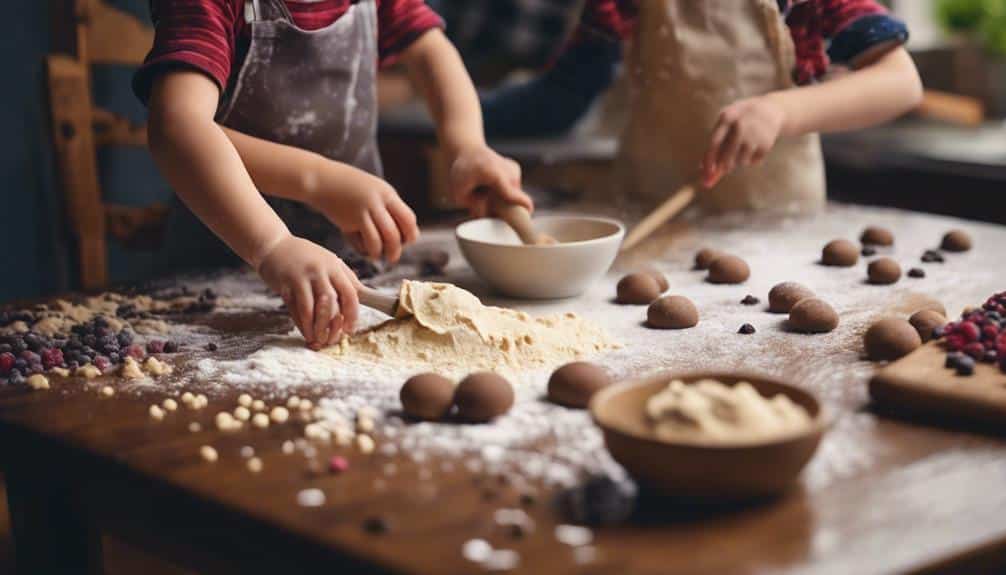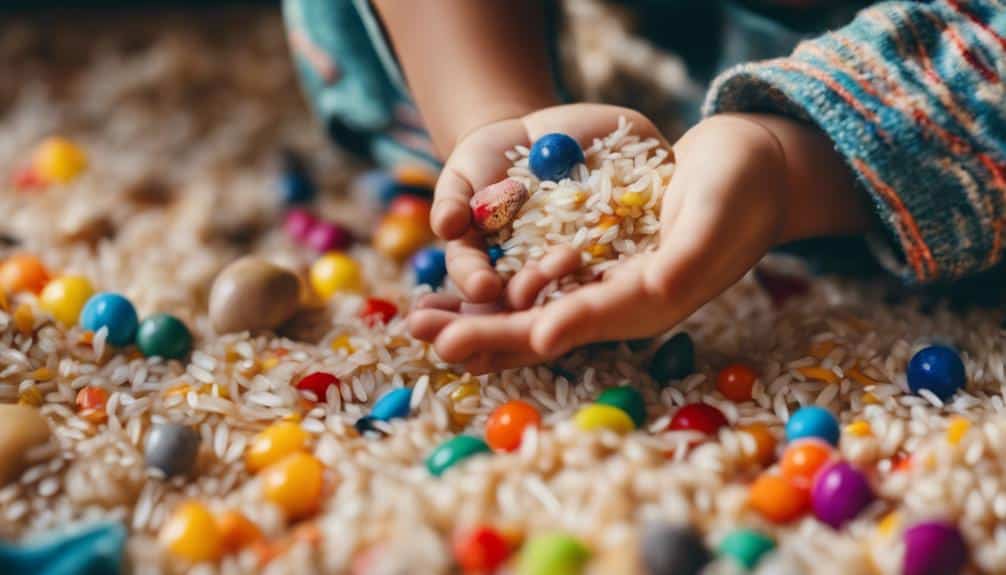Sensory play secrets are pivotal in children’s early development. They engage in activities stimulating their senses and fostering cognitive, physical, and social growth. However, despite the widely acknowledged importance of integrating such play into daily routines, parents and educators often encounter challenges in its practical execution.
This discussion explores five straightforward methods to incorporate sensory play secrets into children’s lives. These methods range from the simplicity of sensory bins to the creative messiness of finger painting and beyond. By delving into these accessible techniques, we invite parents and caregivers to ponder the potential impacts on their child’s developmental trajectory and the enrichment of their learning environment.
What broader implications could these seemingly simple activities have on a child’s growth? Join us as we uncover the transformative power of sensory play secrets and their profound influence on children’s holistic development.
Key Takeaways
- Sensory play bins and finger painting stimulate exploration and enhance fine motor skills.
- Baking sensory adventures teach life skills and promote sensory development.
- Slime creation offers educational and therapeutic benefits through hands-on science.
- Shaving cream exploration encourages creative expression and pre-writing skills.
Sensory Play Bins
Incorporating sensory play bins into a child’s play routine offers a practical and therapeutic method to stimulate their senses. These bins use readily available materials such as dry rice, pasta, beans, small toys, and tools for exploration. Engaging in this form of play allows children to explore, discover, and learn about their world in a safe and controlled environment. Sensory bins can be tailored to each child’s developmental needs and interests, creating an inclusive activity that fosters a sense of belonging.
The tactile experience helps develop fine motor skills while manipulating different textures, which aids cognitive growth. Furthermore, sensory bins provide a therapeutic outlet for children, helping to soothe and calm them through the meditative act of sifting, pouring, and exploring.
Finger Painting Fun
Diving into finger painting offers a tactile and creative avenue for children to express themselves while engaging their senses in a colorful, hands-on manner. This activity fosters artistic growth and encourages sensory exploration, crucial for cognitive and emotional development. Using non-toxic paints on a poster board, children can experiment with mixing colors directly with their hands, enhancing fine motor skills and sensory perception.
Creating initials or abstract designs with tape before painting adds an element of surprise and achievement once the tape is peeled away to reveal crisp lines against a vibrant backdrop. Finger painting is a fun activity and therapeutic tool that nurtures young minds’ sense of accomplishment and belonging.
Baking Sensory Adventures

Embarking on baking sensory adventures offers a multifaceted experience that stimulates touch, smell, and taste, fostering a deeper connection between children and their food. This activity not only engages the senses but also encourages curiosity and creativity. By involving children in the preparation of meals, we not only teach them valuable life skills but also create a sense of belonging and contribution to the family.
| Activity | Sensory Benefit |
|---|---|
| Kneading Dough | Touch: Enhances fine motor skills through the tactile experience of pressing and shaping. |
| Smelling Spices | Smell: Stimulates olfactory senses and creates memory associations. |
| Tasting Ingredients | Taste: Encourages exploration of different flavors, promoting a varied diet. |
Through these simple yet profound experiences, children learn to appreciate the joy of cooking and the importance of nutritious meals while enhancing their sensory development.
Slime Creation
Engaging in slime creation offers a hands-on opportunity to explore science and sensory stimulation, providing educational and therapeutic benefits for children. This activity fosters a sense of belonging and achievement as kids mix essential ingredients like glue, baking soda, and saline solution to create something uniquely theirs. Children express their creativity by customizing the slime with food coloring, glitter, or scents while enhancing their fine motor skills and tactile senses.
Experimenting with different textures and consistencies promotes cognitive development and problem-solving abilities. Storing the slime in airtight bags for reuse encourages responsibility and extends sensory exploration. Slime creation is not just about making a playful substance; it’s about nurturing a child’s curiosity, social skills, and emotional well-being in a safe and inclusive environment.
Shaving Cream Exploration

After exploring slime creation, another effective sensory play activity involves using shaving cream, offering children a unique tactile experience that promotes fine motor development and creative expression. Shaving cream exploration is engaging and therapeutic, providing a soothing medium for children to express their emotions and imagination freely. By spreading shaving cream on a surface, children can practice drawing letters, numbers, and shapes, enhancing their pre-writing skills.
This activity encourages sensory exploration through touch and movement, making learning more dynamic and memorable. Additionally, shaving cream is easy to clean and typically non-staining, making it a practical choice for parents and educators. Incorporating this activity fosters a sense of belonging as children engage in shared experiences that are both fun and educational.
Frequently Asked Questions
How Can I Adapt Sensory Play Secrets for Children With Sensory Processing Issues or Sensitivities?
Adapting sensory play for children with sensory processing issues involves tailoring activities to their comfort levels, using hypoallergenic materials, and gradually introducing sensory stimuli to build tolerance in a safe, inclusive, and therapeutic environment.
What Are Some Effective Ways to Incorporate Sensory Play Into a Routine for Children With ADHD or Autism?
Integrating sensory play into daily routines can calm children with ADHD or autism and enhance their focus. Techniques like sensory bins, finger painting, and baking activities offer therapeutic benefits and practical engagement.
Can Sensory Play Activities Be Beneficial for older children or Adults, and how can they be modified?
Sensory play activities benefit older children and adults by promoting relaxation, enhancing sensory integration, and improving cognitive and motor skills. Adapting these activities with more complex materials and themes can optimize engagement and therapeutic outcomes.
How Can I Ensure Hygiene and Safety When Engaging in Sensory Play Activities, Especially in Group Settings or Classrooms?
Ensuring hygiene and safety in sensory play, especially in communal settings, is paramount. Utilize individual bins, regularly sanitize materials, and introduce non-toxic, washable substances to foster a secure, inclusive environment where creativity and exploration flourish.
What Are Some Budget-Friendly Alternatives for Sensory Play Materials That Can Be Found Around the House?
Use household items like dried beans, pasta, or rice to create budget-friendly sensory play materials. Incorporating these into clear containers with spoons or toys can offer engaging and cost-effective sensory experiences.
Conclusion
Sensory play activities are a fantastic way to help toddlers develop their sensory, motor, and cognitive abilities. Sensory experiences like playing with sand, objects, and items can help children develop their body awareness and observational skills. Sensory materials like cotton balls, lily pads, and pine cones can give children a tactile experience and help them build their sense of touch and proprioceptive input.
Sensory play ideas are a great way to engage your child in meaningful learning experiences. By incorporating sensory items into your child’s daily routine, you can help them develop their language skills, social interaction, and emotional intelligence. Baking, playing with kinetic sand, and exploring the outdoors are all great activities for toddlers that can provide them with a fun and engaging sensory experience.
Talking to a pediatric occupational therapist can be a great way to get ideas for alternative activities and messy play to help your child’s sensory development. They can also help you identify negative touch experiences and suggest ways to turn them into positive experiences. Additionally, a preschool or martial arts program can provide children with opportunities for physical activity and critical thinking skills.
In conclusion, sensory play activities are crucial for a child’s holistic development. They allow children to explore their senses and engage in physical activity. Sensory development is essential for a child’s immediate developmental skills and cognitive and communication skills in the long run. Consider using basic materials like balls, plastic cups, and plastic bottles to create sensory bins for toddlers. Busy Toddler and other childhood educators offer printable activity guides to make it easy to create engaging activities for kids.


Recent Comments